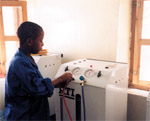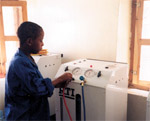
Child Labor: Causes and Solutions [Archives:2001/21/Reportage]
May 21 2001

The social complex phenomenon is the emanation of an economic and social chaos. It reflects the fragile infrastructure of the social fabric in achieving comprehensive and balanced economic and social development so as to meet the needs of the society.
Among the reasons behind the increase in the number of working children are the outbreak of poverty, low living standard of families, children escaping from schools because of the lack of spacious classrooms and qualified teachers.

The said reports added that children labor in the industrial countries can also be seen, though most of those reports were based on surveys conducted during holidays, they gave reasonably reliable numbers that cannot have an error margin more than 50%.
In general, most working children usually work in artistic and trading jobs. According to UNICEF, there are two categories of children labor; the acceptable and the non-acceptable.
The second category puts in its list children who work full time, particularly if they are of an extremely early age. Those children usually spending long hours in working causing substantial harm to the child’s body psychological condition, i.e., heavy load and exhausting jobs in transport locations cause children to be be subject to injuries because of traffic accidents.
The UNICEF stressed that some employers give no chance to children to acquire enough skills or qualification. On the contrary, they oppress, humiliate and degrade their dignity in many ways. There were also some reports of slavery and sexual assault against working children.
In 1919 the international labor office was founded to undertake the responsibility of combating children labor as it listed in its constitution the obligation of reducing work of labor children in industry with article no. 5 – 1919 which prohibited the working of children under 14 in any industry. Moreover it issued accord no. 138-1973 in which it outlined 15 years as a minimum age for children labor and 18 years for the fatigued and dangerous labor. Later on further measures were taken by the international recommendation no. 4 to protect the working children.
Yemen is one of the developing countries which continues to suffer hardly from children labor and in that respect, the government issued resolution no. 5 for 1995 which comprised a number of conditions to organize the work of children.
The locally carried out studies indicated that existing child labor in Yemen was either assistance labor or craftsmanship including smithery, car repair and lubricating, traditional hotel services, grocery and working in the agricultural fields.
In accordance with statistics carried out by Central Organization for Statistics in 1999, it totaled the number of children in the Republic of Yemen at 433,701 between the age of 6 and 14, 25,509 out of them live in the urban and 408,192 live in he rural areas.
Also, some of fielding studies which tackled the social,cultural, health and economical situations of the children, clarified that 15% of them did not enroll in primary school, 97% of the m have illiterate mothers, and 23% chew qat and smoke cigarettes.
The reasons behind child labor in Yemen can be specified by:
1- poverty
2- temptations given by the owners of factories to the children to work
3- the inability of most of poor families to afford the expenses of education, hence they prefer to have their children work instead.
Following approving the accord of the international children rights issued by the UN, our country established a coalition of more than 43 societies, organizations and non-governmental organizations aiming at adopting children issues and defending their rights.
Yet, several recommendations and suggestions were presented for halting the phenomenon of children labor, among them were studying the reasons and creating the programs and strategies that provide alternatives to labor children, and also by providing social security to the poor families and using mass media in explaining perils of children labor and activating the implementation of the laws relevant to children rights.
Yasser M. Abdullah
Yemen Times
——
[archive-e:21-v:2001-y:2001-d:2001-05-21-p:./2001/iss21/report.htm]


